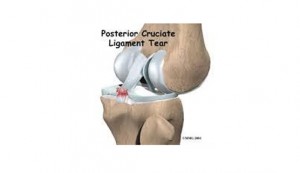Posterior Cruciate Ligament (PCL) Reconstruction
A Posterior Cruciate Ligament (PCL) Reconstruction injury is a partial or complete tearing or stretching of any part of the posterior cruciate ligament (PCL), which is located inside the knee joint. The posterior cruciate ligament (PCL) is located toward the back of the knee, and is one of several ligaments that connect the femur (thighbone) to the tibia (shinbone). The posterior cruciate ligament keeps the tibia from moving backwards too far. PCL injury usually occurs with sudden, direct impact, such as in a car accident or during a football tackle.
Knee ligament repair or reconstruction is a treatment for a complete tear of a knee ligament that results in instability in the knee. People with a torn knee ligament may be unable to do normal activities that involve twisting or turning at the knee. The knee may buckle or “give-way.” If medical treatments are not satisfactory, ligament repair or reconstruction surgery may be an effective treatment
Before the Procedure
- Your doctor will explain the procedure to you and offer you the opportunity to ask any questions that you might have about the procedure.
- In addition to a complete medical history, your doctor may perform a complete physical examination to ensure you are in good health before undergoing the procedure. You may undergo blood tests or other diagnostic tests.
- Notify your doctor if you are sensitive to or are allergic to any medications, latex, tape, and anesthetic agents (local and general).
- Notify your doctor of all medications (prescribed and over-the-counter) and herbal supplements that you are taking.
- You will be asked not to eat or drink anything for six to twelve hours before the procedure, generally after midnight.
- You may receive a sedative prior to the procedure to help you relax. Because the sedative may make you drowsy, you will need to arrange for some to drive you home.
- You may meet with a physical therapist prior to your surgery to discuss rehabilitation.
- Arrange for someone to help around the house for a week or two after you are discharged from the hospital.
Surgery
- The operation is sometimes done as an “open” surgery. This requires a large incision in the knee
- A less-invasive option involves a tool called an arthroscope. The surgeon uses smaller incisions
- If a piece of bone is torn off, a surgeon may fasten the bone back into place using a screw.
- A piece of tendon moved from somewhere else in the body, such as the back of the thigh or heel
- Surgery for a torn PCL requires replacing it with new tissue rather than stitching together the torn ligament. The ligament may be replaced with:
- Tissue from a deceased donor
Recovery After the Procedure
- After the surgery you will be taken to the recovery room for observation. Your recovery process will vary depending on the type of anesthesia that is given. Once your blood pressure, pulse, and breathing are stable and you are alert, you will be taken to your hospital room or discharged to your home. Knee ligament repair is usually done on an outpatient basis.
- You may be given crutches and a knee immobilizer before you go home. Once you are home, it is important to keep the surgical area clean and dry.
- Your doctor will give you specific bathing instructions. The stitches or surgical staples will be removed during a follow-up office visit.
- Take a pain reliever for soreness as recommended by your doctor. Aspirin or certain other pain medications may increase the chance of bleeding. Be sure to take only recommended medications.
- To help reduce swelling, you may be asked to elevate your leg and apply an ice bag to the knee several times per day for the first few days. Your doctor will arrange for an exercise program to help you regain muscle strength, stability, and range of motion.
- Notify your doctor to report any of the following:
- Fever, Redness, or swelling
- Bleeding, or other drainage from the incision site
- Increased pain around the incision site
Recovery from the surgery and rehabilitation may take several months.
Your doctor may give you additional or alternate instructions after the procedure, depending on your particular situation.
Risks of the Procedure
As with any surgical procedure, complications can occur. Some possible complications may include, but are not limited to, the following:
- Bleeding
- Infection
- Blood clots in the legs or lungs
- Continued knee laxity or stiffness
Some individuals experience pain, limited range of motion in the knee joint and occasional swelling in the knee after surgical ligament repair. Others have increased motion in the knee joint as the graft stretches over time.
There may be other risks depending on your specific medical condition. Be sure to discuss any concerns with your doctor prior to the procedure.

